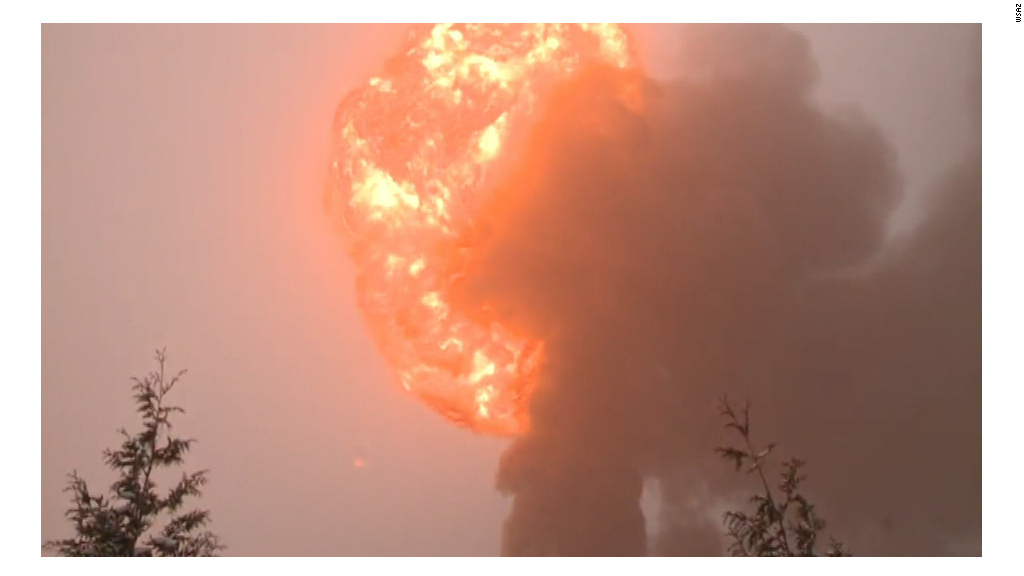
The train derailment and explosion in West Virginia this week is a stark reminder of the dangers of transporting oil by rail.
But it's probably not the last time it will happen.
Put simply, America is awash in oil, but it has limited capacity to move the stuff around in a safe way.
"It's 'pick your poison'," said Kate Hudson, director of the watershed program at the environmental group RiverKeeper. "Every one of the transportation methods for oil is a disaster waiting to happen."
The amount of oil being transported on the nation's railroads has skyrocketed in the years since oil companies figured out how to extract crude from shale deposits.
In 2013, railroads delivered 407,761 carloads of crude, or about 300 million barrels of oil, according to the Association of American Railroads. That's up more than 4,000% from just 9,500 carloads in 2008.
The trend shows no sign of slowing down -- the United States has now become the largest producer of oil in the world. According to research from IHS, the amount of crude oil transported by rail in North America could rise even more, in 2015 and 2016 to 1.5 million barrels per day, compared to just 20,000 barrels per day in 2009.
That means more than 10% of the nation's crude would get to market on a train.
One big concern is that the tanks used to carry oil aren't strong enough and can be easily punctured in an accident.
Hudson said "tin cans on wheels" designed to carry orange juice and corn oil have been pressed into service by the oil industry.
Related: How the oil boom changed the face of small-town North Dakota
What's more, the type of oil being produced in the North Dakota/Canada region is more volatile than other types of crude. It contains higher levels of propane, butane and other natural gases that are highly flammable.
As a result, when a train carrying such crude derails, the results can be catastrophic.
In 2013, a train carrying crude oil from the Canadian oil fields derailed near Lac Mégantic, Quebec, causing explosions that killed 47 people.
Some have called for oil companies to burn off those volatile gases before loading crude onto a train, making it safer to transport.
Public safety advocates also want the government to impose new speed limits on trains and require them to have better brakes.
Related: The story of the great American oil blob
"The federal government hasn't acted," said Hudson. "That failure to act is what's causing these disasters to occur."
The Department of Transportation has issued a series of emergency orders requiring railroads to use more robust train cars to transport oil. But it has yet to make railroads retire train cars that are easily punctured.
Meanwhile, pipelines are considered the safest and most efficient way to move large quantities of oil over long distances.
Most oil in the United States travels by pipeline and seaborne tankers, which accounted for 90% of the crude delivered to refineries in 2013, according to the Congressional Research Office.
But pipelines come with their own problems.
They carry high volumes of crude oil and travel through remote areas. When a pipeline breaks, it can take days to repair and the damage to the environment can be severe.
Just last month, a pipeline in Montana burst and spilled as much as 50,400 gallons into the Yellowstone River, prompting a state of emergency.
Shipping the oil, while cheap, is also risky. The 1989 Exxon Valdez oil spill in Alaska was one of the worst on record before the Deepwater Horizon oil rig exploded in the Gulf of Mexico in 2010.

The bigger problem is geography. The refineries that are equipped to process the type of crude being produced in North Dakota are located far away, in places like Texas, Louisiana, Philadelphia and Delaware.
"There's a mismatch between where the refineries are located, and where the oil is coming out of ground," said Ian Savage, an economist at Northwestern University who studies transportation. "Trains are really the only way to move oil when there are no pipelines."
There are pipelines connecting Canada to the Gulf Coast, but they are running at full capacity, said Savage.
Supporters of the Keystone XL Pipeline say it would help alleviate the bottleneck.
But there aren't any major pipelines to the East Coast, and there are no plans to build any either.
The sharp decline in oil prices over the past few months also makes it highly unlikely that any oil companies will invest in new pipelines anytime soon, said Tyson Slocum, director of Public Citizen's energy program.
Related: Cheap oil killed this CEO's $14 million job
In addition, obtaining permits and rights to build on private property, known as imminent domain, would be next to impossible for a for-profit oil company, he added.
"There's really no easy answer," said Slocum. "But, at this point, because of the big price and logistical challenges with pipeline construction, rail is the way to go for foreseeable future."
